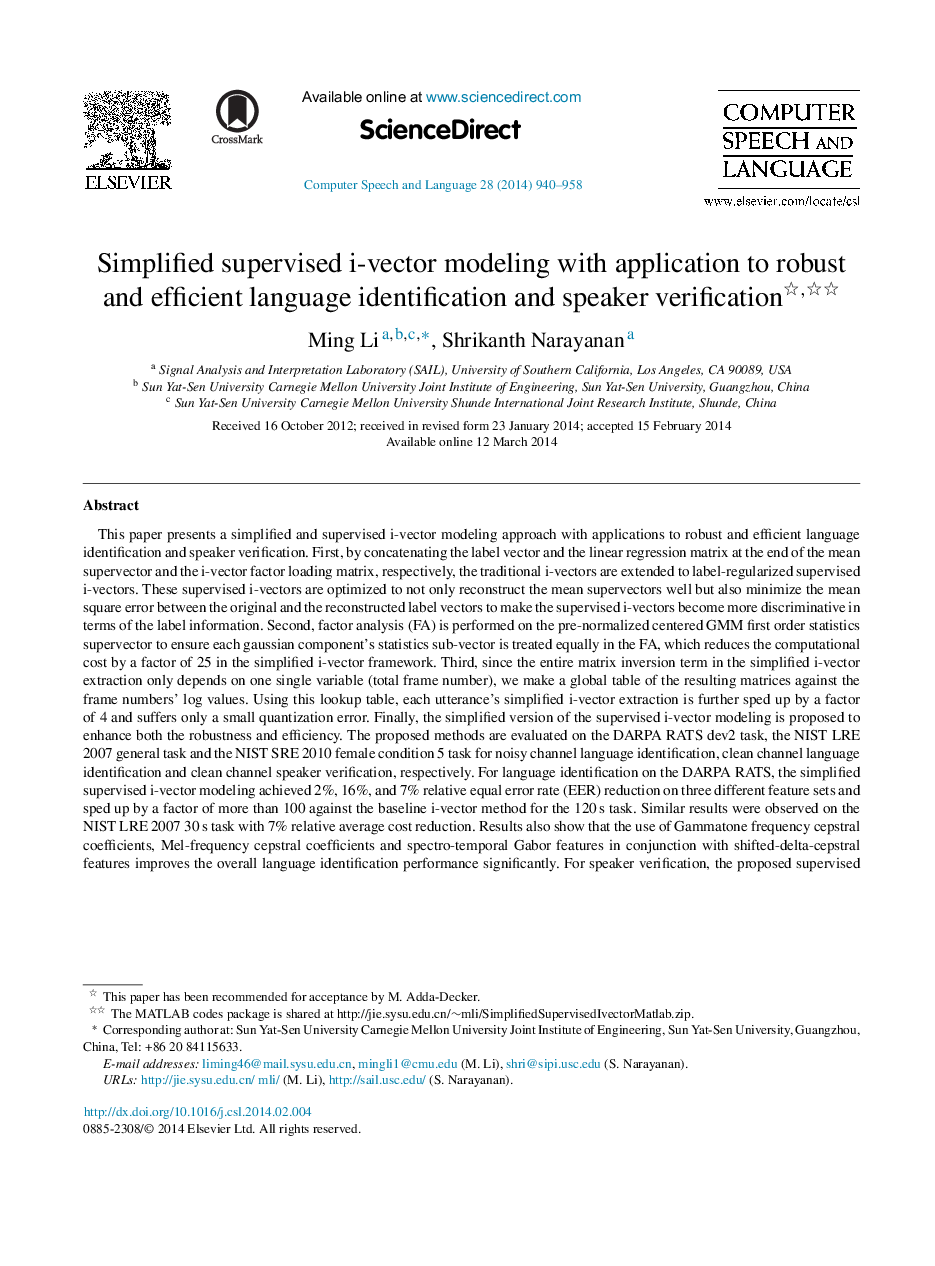| کد مقاله | کد نشریه | سال انتشار | مقاله انگلیسی | نسخه تمام متن |
|---|---|---|---|---|
| 10368492 | 874795 | 2014 | 19 صفحه PDF | دانلود رایگان |
عنوان انگلیسی مقاله ISI
Simplified supervised i-vector modeling with application to robust and efficient language identification and speaker verification
دانلود مقاله + سفارش ترجمه
دانلود مقاله ISI انگلیسی
رایگان برای ایرانیان
کلمات کلیدی
موضوعات مرتبط
مهندسی و علوم پایه
مهندسی کامپیوتر
پردازش سیگنال
پیش نمایش صفحه اول مقاله

چکیده انگلیسی
This paper presents a simplified and supervised i-vector modeling approach with applications to robust and efficient language identification and speaker verification. First, by concatenating the label vector and the linear regression matrix at the end of the mean supervector and the i-vector factor loading matrix, respectively, the traditional i-vectors are extended to label-regularized supervised i-vectors. These supervised i-vectors are optimized to not only reconstruct the mean supervectors well but also minimize the mean square error between the original and the reconstructed label vectors to make the supervised i-vectors become more discriminative in terms of the label information. Second, factor analysis (FA) is performed on the pre-normalized centered GMM first order statistics supervector to ensure each gaussian component's statistics sub-vector is treated equally in the FA, which reduces the computational cost by a factor of 25 in the simplified i-vector framework. Third, since the entire matrix inversion term in the simplified i-vector extraction only depends on one single variable (total frame number), we make a global table of the resulting matrices against the frame numbers' log values. Using this lookup table, each utterance's simplified i-vector extraction is further sped up by a factor of 4 and suffers only a small quantization error. Finally, the simplified version of the supervised i-vector modeling is proposed to enhance both the robustness and efficiency. The proposed methods are evaluated on the DARPA RATS dev2 task, the NIST LRE 2007 general task and the NIST SRE 2010 female condition 5 task for noisy channel language identification, clean channel language identification and clean channel speaker verification, respectively. For language identification on the DARPA RATS, the simplified supervised i-vector modeling achieved 2%, 16%, and 7% relative equal error rate (EER) reduction on three different feature sets and sped up by a factor of more than 100 against the baseline i-vector method for the 120Â s task. Similar results were observed on the NIST LRE 2007 30Â s task with 7% relative average cost reduction. Results also show that the use of Gammatone frequency cepstral coefficients, Mel-frequency cepstral coefficients and spectro-temporal Gabor features in conjunction with shifted-delta-cepstral features improves the overall language identification performance significantly. For speaker verification, the proposed supervised i-vector approach outperforms the i-vector baseline by relatively 12% and 7% in terms of EER and norm old minDCF values, respectively.
ناشر
Database: Elsevier - ScienceDirect (ساینس دایرکت)
Journal: Computer Speech & Language - Volume 28, Issue 4, July 2014, Pages 940-958
Journal: Computer Speech & Language - Volume 28, Issue 4, July 2014, Pages 940-958
نویسندگان
Ming Li, Shrikanth Narayanan,